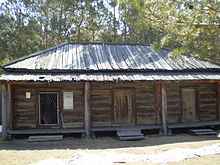Transbaikal Ethnographic Museum
 Entrance gate |
|
| Data | |
|---|---|
| place | Ulan-Ude |
| Art |
open air museum
|
| opening | Founded in 1973 |
The Ethnographic Museum of Transbaikaliens ( Russian Этнографический музей народов Забайкалья " Ethnographic / Ethnological Museum of the Peoples of Transbaikaliens ") is an open-air museum 8 km northeast of Ulan-Ude in Russia . With 40 buildings and 37 hectares, the museum is one of the largest open-air museums in Russia.
history
Around 1960, a number of open-air folk museums were founded in what was then the USSR . This is done for three reasons:
- the growing prosperity
- the development of tourism in the respective region and
- the increase in the number of foreign tourists.
The Folklore Open-Air Museum of the Republic of Buryatia opened on July 6, 1973. The Church of St. Nicholas from Nikolsk ( Muchorschibir Raion ) was one of the first exhibits.
Areas

The museum is divided into several areas:
Archaeological area
The archaeological area consists of a building and an open-air area. In the open-air area there are holy places, stone graves, stone pillars, gate stones and the like. a. the plate grave culture and the Xiongnu culture (here counted among the Huns ) , as well as an ancient settlement of the latter. The first burials of the Xiongnu culture in the Kjachta area were discovered in 1896. Finds of the Xiongnu culture from the lower Ivolginsk ring wall settlement are exhibited in the museum building.
Evenk settlement
The settlement of Evenki consists of several Tschums (small buildings made of larch bark, deerskin and birch bark), shed for supplies, a boat, sleds and other objects of everyday life. There is also a shaman's chum with totems of birds, animals and fish, which were used for the ritual of summoning spirits.
Buryats

The area consists of Buryat yurts made of wood and felt and sacred buildings from Tibetan-Mongolian Buddhism.
In the first half of the 19th century, the Buryat Buddhist temples had domed roofs. In the second half of the 19th century, a new, completely different type of temple appeared. An example of this is the "Dewadschin- (Деваджин)" - ( Sukhavati -) Dugan (individual temple ), which was brought here from the Tamtschinsky-Dazan . The temple was rebuilt in 1926, the external appearance remained unchanged, but the area around the temple was enlarged. Most of the temple was painted yellow, the sacred color of Lamaism . Inside the temple there is a “Tunshi” tablet, on which an Indian legend is depicted, in which four animals advise how to get the fruits of a high tree.
The winter house of the wealthy Buryat SB Safronow (С. Б. Сафронов) is located in the group of buildings from the eastern Baikal region. It originally stood in Chorety (Хореты) in the Irkutsk region and was moved to the museum in 1975.
Old Russian settlers and Cossacks
The group of buildings consists of a village with the typical wooden houses of Cossack leaders , wealthy and poor residents. They stand for the typical social contrasts in most of the villages in the Baikal region.
A barn with three chambers commemorates the Ukrainian ataman Demjan Mnohohrischnyj , who was exiled in 1673. Such huts were built at a distance of 25 km to offer exiles and prisoners on their way to the "Baikal Prison" before the construction of traffic routes.
In the group of buildings is the homestead of a Cossack leader. The house, built in 1880, was moved from the village of Baturino (Батурино) from the Baikal region. Opposite the house is a double-walled barn from the village of Klotschnjowo (Клочнёво, Pribaikalsk Raion ) from 1919.
Houses of the Old Believers
In this group of buildings there are houses built by old Orthodox on one side of a street . To avoid persecution by the authorities, the Old Believers often withdrew to remote areas of Siberia . The houses are from the turn of the century around 1900 and show the different levels of wealth of their residents. A farm of a wealthy farmer from 1861 from the village of Barykino (Барыкино) consists of the farm with all outbuildings including the forge and a small Old Believer chapel . In the house there is an exhibition with plows, harrows, threshing machines, sledges etc. The neighboring house from Nadeina from the late 19th century has four shutters painted with birds. Another two-story house from the 19th century houses a shop, storage room and high porch. The ornate gates were built in 1906 and restored in the museum in 1978.
Urban wooden architecture
Among the many structures in the "Old Verkhneudinsk" group of buildings (name of the city of Ulan-Ude until 1934), a town house with an attic and covered external staircase from 1900 is particularly noteworthy. Opposite this group of buildings is the St. Nicholas Church of the Old Believers.
See also
literature
- Heike Mall, Roger Just: Baikal - See and Region , Reise Know-How series , 3rd edition, Bielefeld 2007, ISBN 978-3-8317-1546-6 , pp. 396–398: “Open-air museum for ethnology Ulan-Ude "
- Bodo Thöns: Siberia: Cities and Landscapes between the Urals and the Pacific , 5th edition, Berlin 2012, ISBN 978-3-89794-200-4 , p. 298: "Ethnographic open-air museum"
Web links
- Этнографический музей народов Забайкалья - официальный сайт музея. Retrieved November 12, 2013 (Russian). - Official website of the museum.
- Ulan-Ude Ethnographic Museum. Russian Information Network, accessed November 9, 2013 .
Individual evidence
- ↑ For the different delimitation of the fields of meaning for Russian Etnografija / Etnologija compared to "western ethnography / ethnology " see: Этнография (Russian Wikipedia, accessed November 16, 2013)
Coordinates: 51 ° 53 ′ 11 " N , 107 ° 38 ′ 54" E






